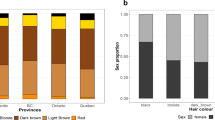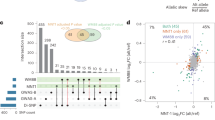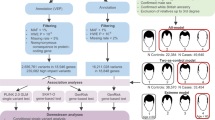Abstract
Hair color differences are among the most obvious examples of phenotypic variation in humans. Although genome-wide association studies (GWAS) have implicated multiple loci in human pigment variation, the causative base-pair changes are still largely unknown1. Here we dissect a regulatory region of the KITLG gene (encoding KIT ligand) that is significantly associated with common blond hair color in northern Europeans2. Functional tests demonstrate that the region contains a regulatory enhancer that drives expression in developing hair follicles. This enhancer contains a common SNP (rs12821256) that alters a binding site for the lymphoid enhancer-binding factor 1 (LEF1) transcription factor, reducing LEF1 responsiveness and enhancer activity in cultured human keratinocytes. Mice carrying ancestral or derived variants of the human KITLG enhancer exhibit significant differences in hair pigmentation, confirming that altered regulation of an essential growth factor contributes to the classic blond hair phenotype found in northern Europeans.
This is a preview of subscription content, access via your institution
Access options
Subscribe to this journal
Receive 12 print issues and online access
$209.00 per year
only $17.42 per issue
Buy this article
- Purchase on Springer Link
- Instant access to full article PDF
Prices may be subject to local taxes which are calculated during checkout





Similar content being viewed by others
References
Sturm, R.A. Molecular genetics of human pigmentation diversity. Hum. Mol. Genet. 18, R9–R17 (2009).
Sulem, P. et al. Genetic determinants of hair, eye and skin pigmentation in Europeans. Nat. Genet. 39, 1443–1452 (2007).
Cruz-Inigo, A.E., Ladizinski, B. & Sethi, A. Albinism in Africa: stigma, slaughter and awareness campaigns. Dermatol. Clin. 29, 79–87 (2011).
Pitman, J. On Blondes (Bloomsbury Publishing, New York, 2003).
Homer. The Iliad of Homer (University of Chicago Press, Chicago, 2011).
Han, J. et al. A genome-wide association study identifies novel alleles associated with hair color and skin pigmentation. PLoS Genet. 4, e1000074 (2008).
Sulem, P. et al. Two newly identified genetic determinants of pigmentation in Europeans. Nat. Genet. 40, 835–837 (2008).
Zhang, M. et al. Genome-wide association studies identify several new loci associated with pigmentation traits and skin cancer risk in European Americans. Hum. Mol. Genet. 22, 2948–2959 (2013).
Kenny, E.E. et al. Melanesian blond hair is caused by an amino acid change in TYRP1. Science 336, 554 (2012).
Hindorff, L.A. et al. Potential etiologic and functional implications of genome-wide association loci for human diseases and traits. Proc. Natl. Acad. Sci. USA 106, 9362–9367 (2009).
ENCODE Project Consortium. An integrated encyclopedia of DNA elements in the human genome. Nature 489, 57–74 (2012).
Praetorius, C. et al. A polymorphism in IRF4 affects human pigmentation through a tyrosinase-dependent MITF/TFAP2A pathway. Cell 155, 1022–1033 (2013).
Yang, J. et al. Common SNPs explain a large proportion of the heritability for human height. Nat. Genet. 42, 565–569 (2010).
Olalde, I. et al. Derived immune and ancestral pigmentation alleles in a 7,000-year-old Mesolithic European. Nature 507, 225–228 (2014).
Morrison-Graham, K. & Takahashi, Y. Steel factor and c-kit receptor: from mutants to a growth factor system. Bioessays 15, 77–83 (1993).
Russell, E.S. Hereditary anemias of the mouse: a review for geneticists. Adv. Genet. 20, 357–459 (1979).
Nocka, K. et al. Molecular bases of dominant negative and loss of function mutations at the murine c-kit/white spotting locus: W37, Wv, W41 and W. EMBO J. 9, 1805–1813 (1990).
Bedell, M.A., Copeland, N.G. & Jenkins, N.A. Multiple pathways for Steel regulation suggested by genomic and sequence analysis of the murine Steel gene. Genetics 142, 927–934 (1996).
Walsh, S. et al. The HIrisPlex system for simultaneous prediction of hair and eye colour from DNA. Forensic Sci. Int. Genet. 7, 98–115 (2013).
Rajeevan, H. et al. ALFRED: the ALelle FREquency Database. Update. Nucleic Acids Res. 31, 270–271 (2003).
Abecasis, G.R. et al. An integrated map of genetic variation from 1,092 human genomes. Nature 491, 56–65 (2012).
Beechey, C.V., Loutit, J.F. & Searle, A.G. Panda, a new Steel allele. Mouse News Lett. 74, 92 (1986).
Bedell, M.A. et al. DNA rearrangements located over 100 kb 5′ of the Steel (Sl)-coding region in Steel-panda and Steel-contrasted mice deregulate Sl expression and cause female sterility by disrupting ovarian follicle development. Genes Dev. 9, 455–470 (1995).
Peters, E.M.J., Tobin, D.J., Botchkareva, N., Maurer, M. & Paus, R. Migration of melanoblasts into the developing murine hair follicle is accompanied by transient c-Kit expression. J. Histochem. Cytochem. 50, 751–766 (2002).
Jordan, S.A. & Jackson, I.J. MGF (KIT ligand) is a chemokinetic factor for melanoblast migration into hair follicles. Dev. Biol. 225, 424–436 (2000).
Boukamp, P. et al. Normal keratinization in a spontaneously immortalized aneuploid human keratinocyte cell line. J. Cell Biol. 106, 761–771 (1988).
Giese, K., Amsterdam, A. & Grosschedl, R. DNA-binding properties of the HMG domain of the lymphoid-specific transcriptional regulator LEF-1. Genes Dev. 5, 2567–2578 (1991).
Travis, A., Amsterdam, A., Belanger, C. & Grosschedl, R. LEF-1, a gene encoding a lymphoid-specific protein with an HMG domain, regulates T-cell receptor α enhancer function. Genes Dev. 5, 880–894 (1991).
Waterman, M.L., Fischer, W.H. & Jones, K.A. A thymus-specific member of the HMG protein family regulates the human T cell receptor Cα enhancer. Genes Dev. 5, 656–669 (1991).
Zhou, P., Byrne, C., Jacobs, J. & Fuchs, E. Lymphoid enhancer factor 1 directs hair follicle patterning and epithelial cell fate. Genes Dev. 9, 700–713 (1995).
DasGupta, R. & Fuchs, E. Multiple roles for activated LEF/TCF transcription complexes during hair follicle development and differentiation. Development 126, 4557–4568 (1999).
van Genderen, C. et al. Development of several organs that require inductive epithelial-mesenchymal interactions is impaired in LEF-1–deficient mice. Genes Dev. 8, 2691–2703 (1994).
Zhang, Y. et al. Activation of β-catenin signaling programs embryonic epidermis to hair follicle fate. Development 135, 2161–2172 (2008).
Love, J.J. et al. Structural basis for DNA bending by the architectural transcription factor LEF-1. Nature 376, 791–795 (1995).
Yun, K., So, J.S., Jash, A. & Im, S.H. Lymphoid enhancer binding factor 1 regulates transcription through gene looping. J. Immunol. 183, 5129–5137 (2009).
Jash, A., Yun, K., Sahoo, A., So, J.S. & Im, S.H. Looping mediated interaction between the promoter and 3′ UTR regulates type II collagen expression in chondrocytes. PLoS ONE 7, e40828 (2012).
Visser, M., Kayser, M. & Palstra, R.J. HERC2 rs12913832 modulates human pigmentation by attenuating chromatin-loop formation between a long-range enhancer and the OCA2 promoter. Genome Res. 22, 446–455 (2012).
Berger, M.F. et al. Compact, universal DNA microarrays to comprehensively determine transcription-factor binding site specificities. Nat. Biotechnol. 24, 1429–1435 (2006).
Newburger, D.E. & Bulyk, M.L. UniPROBE: an online database of protein binding microarray data on protein-DNA interactions. Nucleic Acids Res. 37, D77–D82 (2009).
Tasic, B. et al. Site-specific integrase-mediated transgenesis in mice via pronuclear injection. Proc. Natl. Acad. Sci. USA 108, 7902–7907 (2011).
Grichnik, J.M., Burch, J.A., Burchette, J. & Shea, C.R. The SCF/KIT pathway plays a critical role in the control of normal human melanocyte homeostasis. J. Invest. Dermatol. 111, 233–238 (1998).
Kamberov, Y.G. et al. Modeling recent human evolution in mice by expression of a selected EDAR variant. Cell 152, 691–702 (2013).
Veeman, M.T., Slusarski, D.C., Kaykas, A., Louie, S.H. & Moon, R.T. Zebrafish prickle, a modulator of noncanonical Wnt/Fz signaling, regulates gastrulation movements. Curr. Biol. 13, 680–685 (2003).
DiLeone, R.J., Russell, L.B. & Kingsley, D.M. An extensive 3′ regulatory region controls expression of Bmp5 in specific anatomical structures of the mouse embryo. Genetics 148, 401–408 (1998).
Mortlock, D.P., Guenther, C. & Kingsley, D.M. A general approach for identifying distant regulatory elements applied to the Gdf6 gene. Genome Res. 13, 2069–2081 (2003).
Whitlock, M.C. Combining probability from independent tests: the weighted Z-method is superior to Fisher's approach. J. Evol. Biol. 18, 1368–1373 (2005).
Pfaffl, M.W. A new mathematical model for relative quantification in real-time RT-PCR. Nucleic Acids Res. 29, e45 (2001).
Acknowledgements
We thank R. Moon (University of Washington) for the XE237 LEF1 expression plasmid, R. Nusse (Stanford University) for the SuperTOPFlash plasmid, C. Lowe (Stanford University) for help with statistical and 1000 Genomes Project analysis and members of the Kingsley laboratory for useful comments on the manuscript. This work was supported in part by the University of Georgia Research Foundation (M.A.B.) and by US National Institutes of Health grants GM65393 (M.A.B.), R01-NS050835 (L.L.) and a Center of Excellence in Genomic Science award 5P50HG2568 (D.M.K.). L.L. and D.M.K. are investigators of the Howard Hughes Medical Institute.
Author information
Authors and Affiliations
Contributions
C.A.G. and D.M.K. conceived and oversaw the project. M.A.B. isolated and sequenced the Slpan breakpoint. B.T. and L.L. provided advice, reagents and mice for generating site-specific integrants. C.A.G. performed the gene expression analysis in Slpan mutants, carried out the transgenic analysis of the blond-associated GWAS interval, identified the hair follicle enhancer and performed in vitro and in vivo tests of the effects of the rs12821256 polymorphism. C.A.G. and D.M.K. wrote the manuscript with input from all authors.
Corresponding author
Ethics declarations
Competing interests
The authors declare no competing financial interests.
Integrated supplementary information
Supplementary Figure 1 H2 transgenic embryos.
Fifteen transgenic embryos produced by pronuclear injection with the 6.7-kb H2 plasmid are shown. Each embryo represents an independent genomic integration event. Embryos were collected at E16.5, stained for lacZ activity and bisected before imaging to show both external lateral (l) and internal medial (m) expression patterns. The skin (n = 13) and kidney (n = 14) were consistent sites of expression. The asterisk denotes the position of the kidney in the internal images. Scale bar, 1 mm.
Supplementary Figure 2 H2b transgenic embryos.
Thirteen transgenic embryos produced by pronuclear injection with the 1.5-kb H2b plasmid are shown. Each embryo represents an independent genomic integration event. Embryos were collected at E16.5, stained for lacZ activity and bisected before imaging to show both external lateral (l) and internal medial (m) expression patterns. The kidney (n = 12) was the only consistent site of expression. The asterisk denotes the position of the kidney in the internal images. Scale bar, 1 mm.
Supplementary Figure 3 HFE transgenic embryos.
Eleven transgenic embryos produced by pronuclear injection with the 1.9-kb HFE clone are pictured. Each embryo represents an independent genomic integration event. Embryos were collected at E16.5, stained for lacZ activity and bisected before imaging to show both external lateral (l) and internal medial (m) expression patterns. Hair/skin expression was visible in 8 of the 11 embryos. The asterisk denotes the position of the kidney in the internal images. Scale bar, 1 mm.
Supplementary Figure 4 H2-BLD transgenic embryos.
Nine transgenic embryos produced by pronuclear injection with the 6.7-kb H2-BLD plasmid are shown. Each embryo represents an independent genomic integration event. Embryos were collected at E16.5, stained for lacZ activity and bisected before imaging to show both external lateral (l) and internal medial (m) expression patterns. Hair/skin (n = 7) and kidney (n = 7) were consistent sites of expression. No clear difference in expression compared to the complete set of H2 (H2-ANC) transgenic embryos was evident (see Supplementary Fig. 1). The asterisk denotes the position of the kidney in the internal images. Scale bar, 1 mm.
Supplementary Figure 5 H2-DEL transgenic embryos.
Eight transgenic embryos produced by pronuclear injection with the 6.7-kb H2-DEL plasmid are shown. Each embryo represents an independent genomic integration event. Embryos were collected at E16.5, stained for lacZ activity and bisected before imaging to show both external lateral (l) and internal medial (m) expression patterns. Seven of the embryos show hair/skin expression. However the strength of this staining appeared reduced compared to H2-ANC and H2-BLD embryos, particularly in embryos that showed comparably strong kidney expression (such as embryos 2 and 5). The asterisk denotes the position of the kidney in the internal images. Scale bar, 1 mm.
Supplementary Figure 6 Additional pigmentation phenotypes seen in hair enhancer-Kitl mice.
BLD-Kitl/+ and ANC-Kitl/+ heterozygotes exhibit several altered pigmentation patterns compared to wild-type (FVB/C57BL/6J F1 hybrid) littermates. At 2 months, ectopic pigmentation is seen on the muzzles (arrowheads in a) and the epithelium of the antitragus and ear canal (arrows in b–d). In contrast, BLD-Kitl/+ and ANC-Kitl/+ heterozygotes show reduced pigmentation in the whiskers (arrows in a) and the hair on the digits (arrows in e), perhaps because of competitive interactions between body sites for melanocyte colonization and development48 or premature differentiation of migrating melanocytes49. (f–h) Cross-sections (6 μm) through dorsal skin from 2-month-old (f) wild-type, (g) BLD-Kitl/+ and (h) ANC-Kitl/+ heterozygotes counterstained with nuclear fast red. Elevated Kitl expression controlled by both the BLD and ANC hair enhancers leads to ectopic pigmentation of the bulge region of hair follicles (arrows) and the basal epidermis (asterisks). DP, dermal papilla. Scale bars, 30 μm.
Supplementary Figure 7 Analysis of pigment levels in zigzag hairs from site-specific transgenic mice.
(a) Photographs of zigzag hairs from wild-type (+/+; FVB/C57BL/6J F1 hybrid), BLD (BLD-Kitl/+) line 2 and ANC (ANC-Kitl/+) line 2 heterozygotes at P21. Fifteen hairs per mouse were analyzed to determine the fraction of pigmented pixels per hair shaft. (b) Mean pigmentation density in different genotypes. Both BLD-Kitl/+ and ANC-Kitl/+ heterozygotes exhibit significantly higher levels of pigmentation than wild-type controls. Notably, the amount of pigment in BLD-Kitl/+ heterozygotes is also significantly less than is found in ANC-Kitl/+ heterozygotes (P = 0.0278). Error bars indicate s.e.m. Unpaired t-test values; *P < 0.05, **P < 5 ×10–3.
Supplementary information
Supplementary Text and Figures
Supplementary Figures 1–7 and Supplementary Tables 1 and 2 (PDF 2083 kb)
Rights and permissions
About this article
Cite this article
Guenther, C., Tasic, B., Luo, L. et al. A molecular basis for classic blond hair color in Europeans. Nat Genet 46, 748–752 (2014). https://doi.org/10.1038/ng.2991
Received:
Accepted:
Published:
Issue Date:
DOI: https://doi.org/10.1038/ng.2991
This article is cited by
-
Similarity and diversity of genetic architecture for complex traits between East Asian and European populations
BMC Genomics (2023)
-
Tracking footprints of artificial and natural selection signatures in breeding and non-breeding cats
Scientific Reports (2022)
-
A large Canadian cohort provides insights into the genetic architecture of human hair colour
Communications Biology (2021)
-
Establishment of a Cre-rat resource for creating conditional and physiological relevant models of human diseases
Transgenic Research (2021)
-
An integrated analysis of public genomic data unveils a possible functional mechanism of psoriasis risk via a long-range ERRFI1 enhancer
BMC Medical Genomics (2020)



